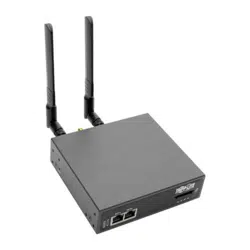Loading ...
Loading ...
Loading ...

239
15. Advanced Configuration
If restoring to a new unit or one that has been factory defaulted, it is important to make sure the process generating SSH keys
is either stopped or completed before restoring configuration. If this is not done, then a mix of old and new keys may be put in
place.
As SSH uses these keys to avoid man-in-the-middle attacks, logging in may be disrupted.
15.2 Advanced Portmanager
Tripp Lite’s portmanger program manages the console server serial ports. It routes network connection to serial ports, checks
permissions, and monitors and logs all the data flowing to/from the ports.
15.2.1 Portmanager Commands
pmshell
The pmshell command acts similar to the standard tip or cu commands, but all serial port access is directed via the
portmanager.
Example: To connect to port 8 via the portmanager:
# pmshell -l port08
pmshell Commands:
Once connected, the pmshell command supports a subset of the ‘~’ escape commands that tip/cu support. For SSH you
must prefix the escape with an additional ‘~’ command (i.e. use the ‘~~’ escape).
Send Break: Typing the character sequence ‘~b’ will generate a BREAK on the serial port (if you are doing this over SSH,
you will need to type ‘~~b’)
History: Typing the character sequence ‘~h’ will generate a history on the serial port.
Quit pmshell: Typing the character sequence ‘~.’ will exit from pmshell.
Set RTS to 1 run the command: pmshell --rts=1
Show all signals: # pmshell –signals
3DSR=1 DTR=1 CTS=1 RTS=1 DCD=0
Read a line of text from the serial port: # pmshell –getline
Notes: Firmware version 3.5.2 and later includes pmshell escape command so you can now hit ~m from a connected serial port to drop
back to pmshell.
For console servers running firmware version 3.11.0 and above, pmshell has a set of built-in key sequences to access the
power menu, return to the serial port selection menu, and so on. Extra controls (key sequences) can be added to the built-in
key sequences and configured per serial port. All ports can behave the same or selectively add control sequences. The controls
can be different from port to port for the same function.
For example, you could configure pmshell so that when you are using serial port 2, pressing Ctrl+p would take you straight to
the power menu for that port.
The pmshell control commands are configured only via the command line.
A helper script configures a control command on a range of serial ports to eliminate the cumbersome task of entering the
configuration command for every port. You will still need to use this script once per control function (see below). There are only
six control functions.
pmshell control functions and their built in key sequences:
~b - Generate BREAK - send a break to the console.
~h - View history - see the traffic logs for the port (must have port logging enabled).
~p - Power menu - open the power menu for the port (port must be configured for an RPC).
~m - Connect to port menu - go back to the serial port selection menu.
~. - Exit pmshell - exit pmshell completely.
~? - Show help message - shows the help message.
Loading ...
Loading ...
Loading ...
